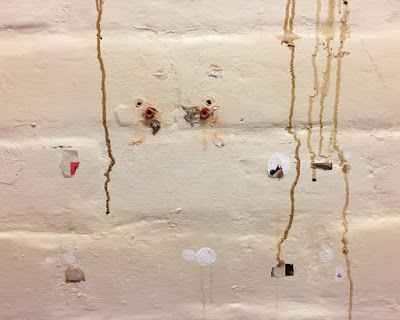It was a dark rainy afternoon.
Inside it was dark and gloomy, particuarly in the cells.
A case full of photographs of early inmates was compelling.
The overiding feeling was of oppression and a shock at the small spaces that prisoners were confined in for 23 hours per day.
When allowed out of their cell they were not allowed to see the faces of other prisoners; made to wear a hood.
More recently the prison has been used for young offenders until it closed in 2013.
A stainless steel sink, toilet and mirror.
A metal table and stool.
Enough to test the sanity of the toughest.
Art made in response to the site focussed on light/absence of light, the absence of free running water and letters of separation.
Oscar Wilde was incarcerated here from 1895 until 1897 for reasons of his sexual orientation. He wrote De Profundis when finally allowed writing materials towards the end of his stay.
Nan Goldin's work makes direct reference to the reasons for his incarceration.
Steve McQueens gold mosquito net bathes a cell in light,
and a bird is free to fly in the corridor in work by Gonzales -Torres.
The chapel held the original door to Oscar Wilde's cell. The plinth is the same size as the cell, and from it readings have been given of De Profundis.
I can only wonder what happens next to the building.
"outside the day may be blue and gold, but the light that creeps down through the thickly muffled glass of the small iron-barred window beneath which one sits is grey and niggard. it is always twilight in one's cell, as it is always midnight in one's heart"
Oscae Wilde, De Profundis, 1897















































